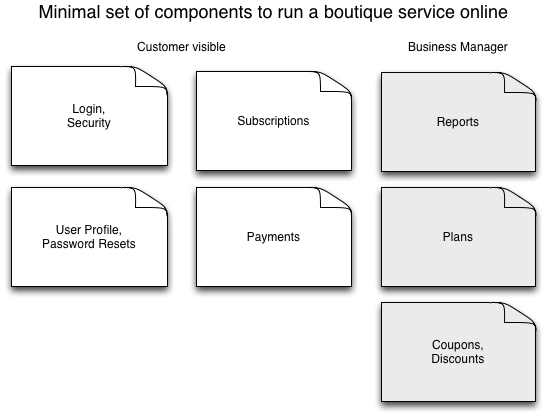How to bring your own service online
by Joe Bonadio on Thu, 11 Jun 2015
 There are two opinions when it comes to building a service on the Internet:
if you are willing to work for free for a while, you don’t need much capital
to start a web service - $37 is enough.
On the other hand, the math of SaaS favor large amounts of capital early.
Surprisingly both lines of reasoning are true.
There are two opinions when it comes to building a service on the Internet:
if you are willing to work for free for a while, you don’t need much capital
to start a web service - $37 is enough.
On the other hand, the math of SaaS favor large amounts of capital early.
Surprisingly both lines of reasoning are true.
If you are thinking in terms of hundreds of millions in return within 5 years, then you are in startup land. You must structure your business for exponential growth in every direction: capital funding, employees, customer acquisition, etc. Soon you realize a $100M target is not attractive to venture capitalists. The economics of their profession requires bigger, bolder bets.
Whether you are an educator giving classroom training, a software freelancer or
an accountant specializing in real estate, the move from a website with contact
information to a web service with a big smile and a human touch is natural.
With a combination of web automation and professional services, pulling in
$1M/year as opposed to $100K/year is not only fulfilling, it feels more secure
than a 401K invested with Wall Street. If this is you - the bootstrapped
boutique service entrepreneur - this article is dedicated to you.

One of the most compelling arguments for building a Service delivered as a Software is that you can do it on a shoestring and be profitable within a few months. No ‘Angel’, no Venture Capital, fully bootstrapped. The Magic Bullet? Focus on revenue from Day 1.
Day 1: Focus on revenue
If you don’t seek outside investment, you likely have just a few thousand dollars saved up - and money goes very fast.
One famous advocate of the bootstrap model is David Heinemeier Hansson of 37signals; another strong proponent of focusing on revenue early on is Hasan Mirjan of SphereMail, both a friend and client. Dane Maxwell, founder of The Foundation, transformed the bootstrap service art into a process.The premise is that many markets are still organized around ad-hoc solutions, and in these markets software can bring 10x productivity increases. That being said, the process goes something like this:
- Pick a market
- Find the major pain for someone in that market
- Sell a subscription-based online solution
- Build it
A lot of serendipity goes into picking a market. If you are already providing professional services in a specific market offline you are halfway there. If not, there are indicators that can help you size up any opportunity. A market with a lot of hiring going on is growing; you can look at job postings. A market that advertises a lot is competitive, and there is extra money to spare there: the more a market is profit-oriented, the easier the sale.
Once you have chosen the market, you need to identify the most painful day-to-day activities. That requires you to write down a thorough list of questions, and talk to as many people as possible. (Note: most would-be entrepreneurs never get past this part.)
Identify key challenges in 3 basic steps:
- Write out a script to guide your phone calls. At this point, you need to identify the key challenges faced by your target market, so the script should focus on this.
- Gather a list of one hundred people in that market. With all the services online today, this is relatively easy.
- Get on the phone.
The numbers are pretty consistent: An introduction email to 100 people will
lead to roughly 30 completed follow-up phone calls, resulting in about 10 leads.
Cold calling is hard; you will have to go outside your comfort zone. You are
thus better off knowing sooner rather than later if you can pass the bar -
before you invest much time and money in your project. And by talking early
with people in the market, you get validation before investing significant
resources. You will also have time to home in on the likeliest buyers, and learn
their titles, day-to-day worries, and emotional biases.

One of the best example of this highly focused approach was given by Joel Gascoigne when he stopped by a San Francisco Financial Startup Meetup while he was in town. Joel did an excellent job of telling the story of Buffer’s start, a not-unusual account of starting a business on the side and building it through paying customers.
From a mere two pages (Page 1 read "This is Our Service"; Page 2 read "Sorry, you caught us before we’re ready. Please enter your email for updates.”) he managed to confirm that his business idea was sound.
Very early on, Paypal was integrated…well, sort of. (Joel would quickly log into the database and flip "activated" on a user entry each time he received an e-mail from Paypal that a user had paid.) By guest posting on various blogs, actively managing his Twitter feed and monitoring statistics using Mixpanel, Joel eventually got to the point where he could stop freelancing and dedicate himself to Buffer full-time.
To confirm your business idea is sound:
- Make a landing page
- Gather email addresses
- Collect pre-payments for delivery at a later date
- Refund the first few customers if the product does not fly before expected delivery date.
Joel also cited some interesting numbers:
- 400,000+ registered users
- 1.7% conversion rate
- $10/month membership
We ran the math, and here’s what we found. As a pure web business, meaning virtually all expenses are wages, it translates to a break even with 7 full-time employees. This was confirmed a week later by an article in Techcrunch. Great way to start!
Day 2: Sales, sales, sales
One minute. That's about how long an average person can hold their breath. A few days? That's how long a business can survive without cash. It’s a harsh reality: Sales and its resultant influx of cash is as critical to a business’ survival as oxygen is to yours.
The Ultimate Sales Machine by Chet Holmes is one of the most thorough books on the subject of sales. If you are trained engineers turned entrepreneurs like our founders, start with this quote:

Then, think about the product you are building. If you’re still on board, start selling - or go home.
There is always a tension between sales and engineering, one well illustrated by the differences in the recruiting process for the two disciplines. There are commonalities, however. A successful career in either field requires a certain amount of bull-headed determination; Engineers respect a "it's not done until it's done" attitude, something that is part and parcel of sales. They also respect careful attention to detail.
In The Ultimate Sales Machine, Holmes shows us that the best performers in sales are highly prepared and determined. They devise a process, write scripts, think ahead about potential objections and prepare for them. As in any science, skills are acquired through repetition.
This is the common ground to build a synergy between sales and engineering. Why? It’s simple: aligning your sales and development cycles is critical to your company cash flow, and cash is survival. Cash is true profit.
Engineering is very much about looking inwards to solutions. In that sense, engineers are perfect buyers. Software developers are always on the outlook for new technology, new programming languages, something to give them an edge to build better products. To become a great salesman, you must think through the eyes of your prospect. What would you do if you were tasked to solve her problem? Would the product you are building do the job?
These questions are fundamental, because benefits to the client always drive sales, and are the basis of value-based pricing. Nothing sums it up better than this recent article: What A Dead Squirrel Taught Me About Value pricing.
Day 3: Build it
When you've managed to pre-sale enough subscriptions to a service, it's time to deliver. Often that’s where a non-coder will struggle to find a competent, cheap and serious contractor. Remember day 2. It is a lot easier with cash in hand to build it. A coder founder will have an advantage here in the beginning, but most likely will go through the painful lessons of understanding the benefits of implementing discounts, double ledger accounting in the face of charge-backs, or simply the security trade-off once someone is allowed to use their email address as a username.
You won't get by with a single monthly plan. Pre-payments, discounts,
anything that makes it easy to find out what customers are willing to pay,
when and how, is a golden feature.

All in all we learned that up to 80% of the code in a service business is boiler plate authentication and subscription. When you have a few thousand dollars and very little time, that's a lot of work, difficult to get right, before even starting on the service you deliver. You definitely want to look for open source frameworks and/or host your service on a professionally maintained platform like DjaoDjin.
Summary
Services are meant to evolve. There is often a feedback loop but don't make the mistake of running against the wheel. 1) Price it, 2) Sell it, 3) Build it. As they say in Hollywood: ”It ain't called 'show art', kid. It’s show business.”
More to read
More technical posts are also available on the DjaoDjin blog, as well as business lessons we learned running a SaaS application hosting platform.
